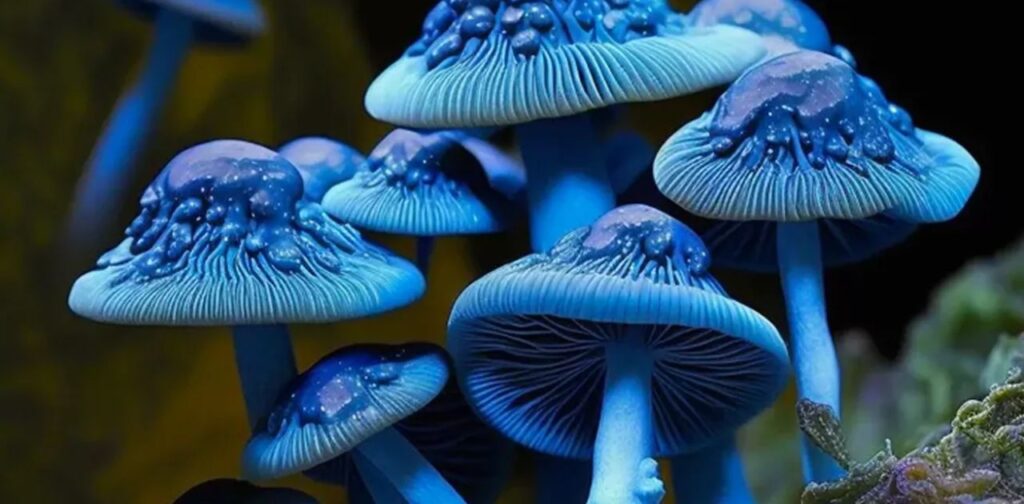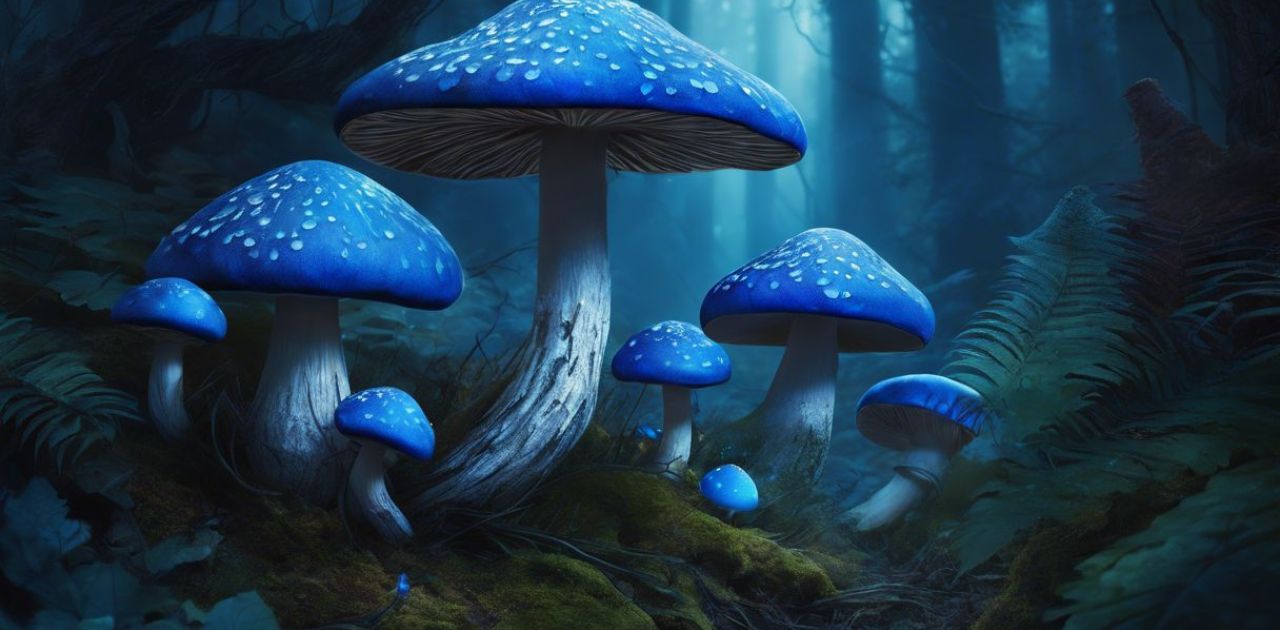Blue Meanie Mushroom, scientifically known as Panaeolus Cyanescens, stands as a captivating specimen in the world of psychedelic fungi, renowned for its potent psychoactive properties and rich cultural heritage. From its distinctive blue bruising to its profound effects on consciousness, this mushroom species has intrigued and inspired individuals for generations.
In this comprehensive guide, we embark on a journey to explore the characteristics, psychoactive properties, cultivation techniques, legal status, safety considerations, historical significance, and ongoing research surrounding Blue Meanie Mushroom. Through this exploration, we aim to unravel the mysteries of this enigmatic fungus and shed light on its potential for therapeutic use and personal transformation.
Overview of Panaeolus Cyanescens
Panaeolus Cyanescens, commonly known as Blue Meanie Mushroom, is a species of psychedelic mushroom that belongs to the Panaeolus genus. It is renowned for its potent psychoactive properties and has been traditionally used in various cultures for spiritual and recreational purposes.
In this comprehensive guide, we will delve into the characteristics, psychoactive properties, cultivation techniques, legal status, safety considerations, historical significance, and ongoing research surrounding Blue Meanie Mushroom.
Characteristics of Blue Meanie Mushroom
Blue Meanie Mushroom is characterized by its distinctive blue bruising when damaged, which is attributed to the presence of psilocin and psilocybin, the psychoactive compounds responsible for its effects. It typically grows in subtropical and tropical regions, often found in grassy areas, pastures, and woodchips. The mushroom features a conical to bell-shaped cap with a diameter ranging from 1 to 3 centimeters, and a slender, cylindrical stem that can reach heights of up to 10 centimeters. Its spore print is dark purplish-brown.
Psychoactive Properties of Blue Meanie Mushroom

Blue Meanie Mushroom contains psychoactive compounds such as psilocin and psilocybin, which interact with serotonin receptors in the brain, leading to alterations in perception, mood, and cognition. The effects of consuming Blue Meanie Mushroom can vary depending on factors such as dosage, individual tolerance, and setting. Common effects include euphoria, visual hallucinations, altered sense of time, and enhanced introspection. Some users report profound spiritual experiences and insights.
Research suggests that psychedelics like Panaeolus Cyanescens may have therapeutic potential for treating various mental health conditions, including depression, anxiety, and post-traumatic stress disorder (PTSD).
Studies have shown promising results in using psychedelics-assisted therapy to facilitate emotional processing, enhance mindfulness, and promote personal growth. However, further research is needed to fully understand the therapeutic mechanisms and long-term effects of Blue Meanie Mushroom.
Cultivation of Blue Meanie Mushroom
Cultivating Blue Meanie Mushroom can be done using various methods, including indoor and outdoor cultivation. The process typically involves inoculating a substrate, such as grain or straw, with mushroom spores or mycelium, and providing suitable environmental conditions for growth.
Blue Meanie Mushroom thrives in a warm, humid environment with proper air circulation and sufficient moisture. It is important to maintain sterile conditions during the cultivation process to prevent contamination and ensure successful mushroom production.
Legal Status of Blue Meanie Mushroom
The legal status of Blue Meanie Mushroom varies depending on location and jurisdiction. In many countries, including the United States and Canada, psychedelic mushrooms are classified as Schedule I controlled substances, meaning they are illegal to possess, cultivate, or distribute for recreational use. However, there is growing interest in reforming drug policies to allow for the medical and therapeutic use of psychedelics under controlled conditions. Some jurisdictions have decriminalized or legalized psychedelic mushrooms for personal use or research purposes.
Safety and Risks Associated with Blue Meanie Mushroom
While Blue Meanie Mushroom is generally considered safe when used responsibly, there are potential risks and side effects associated with its consumption. Common side effects may include nausea, vomiting, anxiety, paranoia, and confusion, especially at higher doses.
It is important to start with a low dose and gradually increase as needed to minimize the risk of adverse reactions. Individuals with a history of mental health issues or substance abuse should exercise caution when using psychedelic mushrooms and consult with a healthcare professional if necessary.
Historical and Cultural Significance of Blue Meanie Mushroom
Blue Meanie Mushroom has a long history of use in indigenous cultures for spiritual, religious, and healing purposes. In many traditions, psychedelic mushrooms are revered as sacred sacraments and are used in rituals and ceremonies to induce altered states of consciousness and facilitate spiritual experiences.
Today, the use of psychedelic mushrooms continues to hold cultural significance for many communities, and there is a growing interest in preserving and revitalizing traditional practices while also exploring new avenues for therapeutic and recreational use.
Research and Future Directions for Blue Meanie Mushroom
Despite decades of prohibition and stigma surrounding psychedelic substances, there has been a resurgence of scientific interest in exploring the therapeutic potential of Blue Meanie Mushroom and other psychedelics. Recent studies have shown promising results in using psychedelics-assisted therapy to treat mental health conditions, addiction, and existential distress. Ongoing research aims to elucidate the underlying mechanisms of action, optimize treatment protocols, and expand access to psychedelic-assisted therapy for those in need.
Conclusion
In conclusion, Blue Meanie Mushroom, or Panaeolus Cyanescens, is a fascinating psychedelic mushroom with a rich history, potent psychoactive properties, and promising therapeutic potential. While there are risks associated with its use, when approached with respect and caution, Blue Meanie Mushroom has the potential to offer profound insights, healing experiences, and transformative growth.
As research in the field of psychedelic science continues to evolve, it is essential to foster an open dialogue, promote responsible use, and explore new frontiers in understanding the mind and consciousness.
FAQ’s
What is Blue Meanie Mushroom?
Blue Meanie Mushroom, scientifically known as Panaeolus Cyanescens, is a species of psychedelic mushroom renowned for its potent psychoactive properties.
What are the effects of consuming Blue Meanie Mushroom?
Consumption of Blue Meanie Mushroom can lead to a variety of effects, including euphoria, visual hallucinations, altered sense of time, and enhanced introspection.
How do I cultivate Blue Meanie Mushroom?
Blue Meanie Mushroom can be cultivated using various methods, including indoor and outdoor cultivation. It typically involves inoculating a substrate with mushroom spores or mycelium and providing suitable environmental conditions for growth.
Is Blue Meanie Mushroom legal?
The legal status of Blue Meanie Mushroom varies depending on location and jurisdiction. In many countries, psychedelic mushrooms are classified as Schedule I controlled substances, making them illegal to possess, cultivate, or distribute for recreational use.
What are the potential risks associated with Blue Meanie Mushroom?
While Blue Meanie Mushroom is generally considered safe when used responsibly, potential risks include nausea, vomiting, anxiety, paranoia, and confusion, especially at higher doses.
What is the historical significance of Blue Meanie Mushroom?
Blue Meanie Mushroom has a long history of use in indigenous cultures for spiritual, religious, and healing purposes. It continues to hold cultural significance for many communities around the world.
Read Also: Penis Envy Mushrooms

